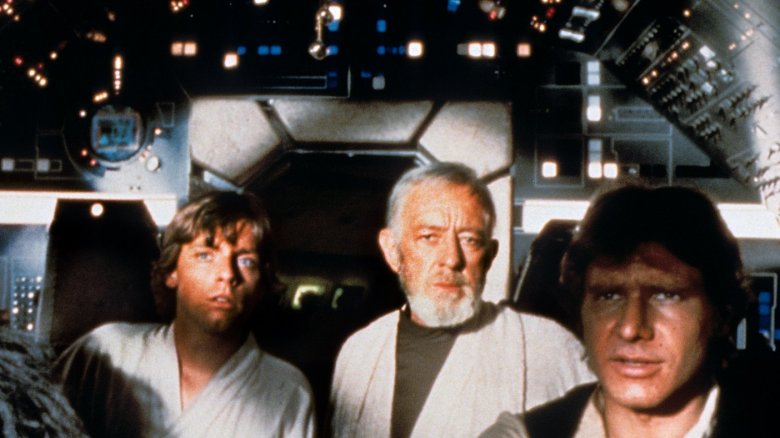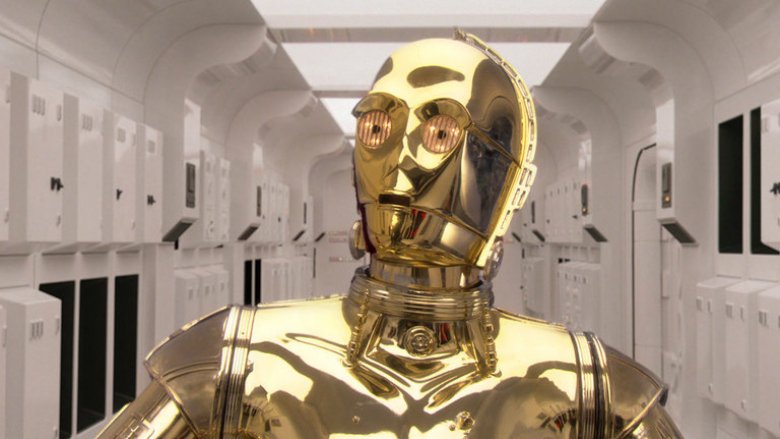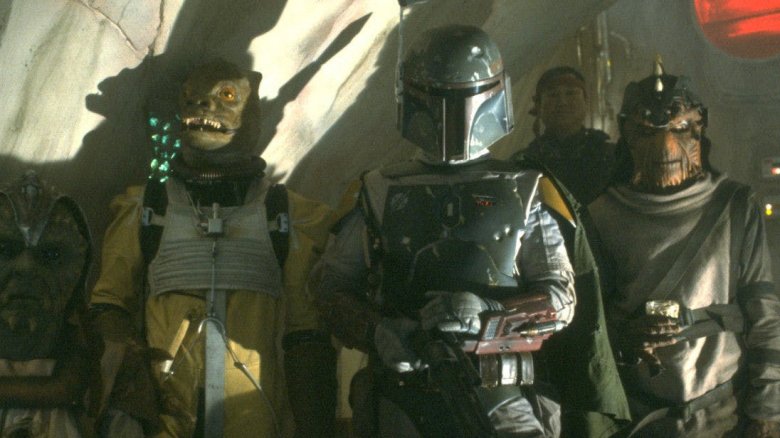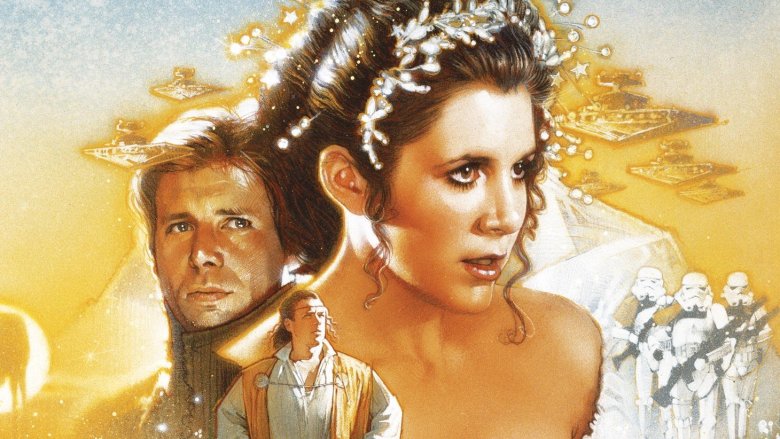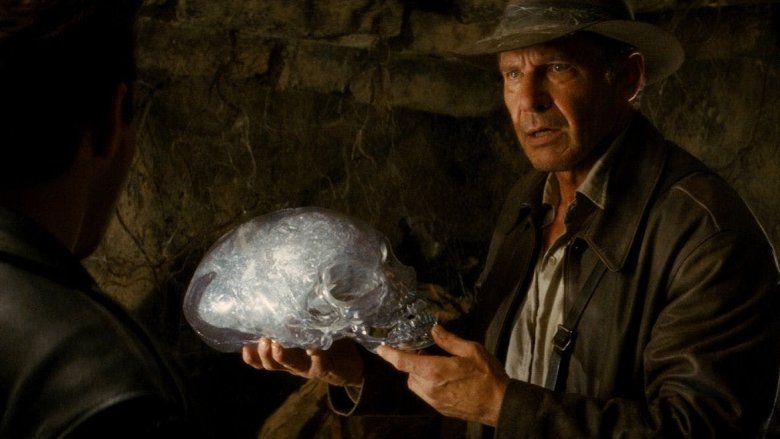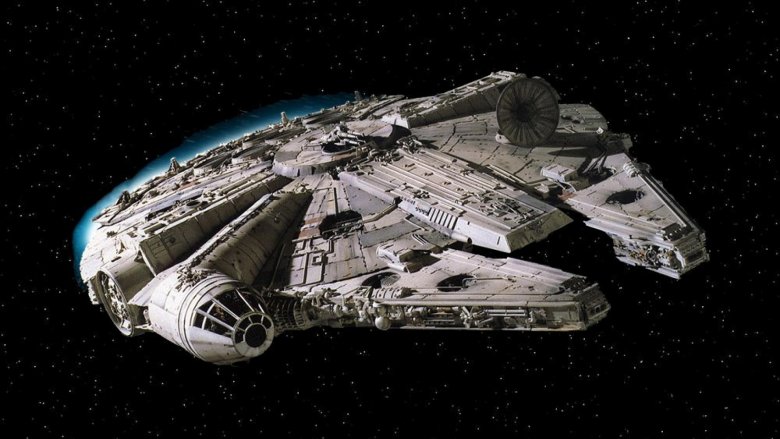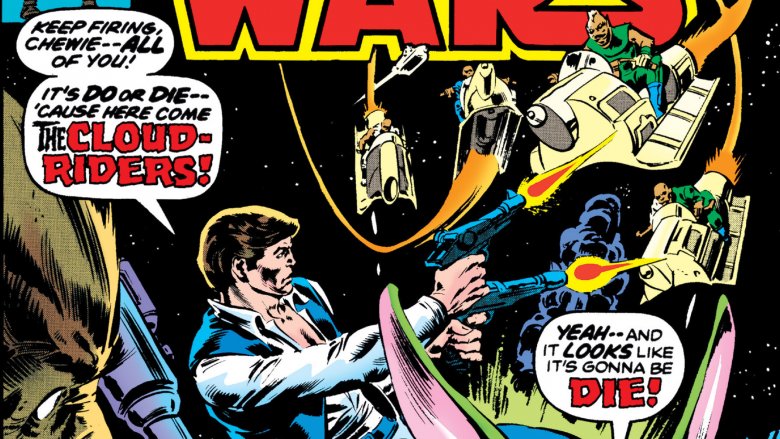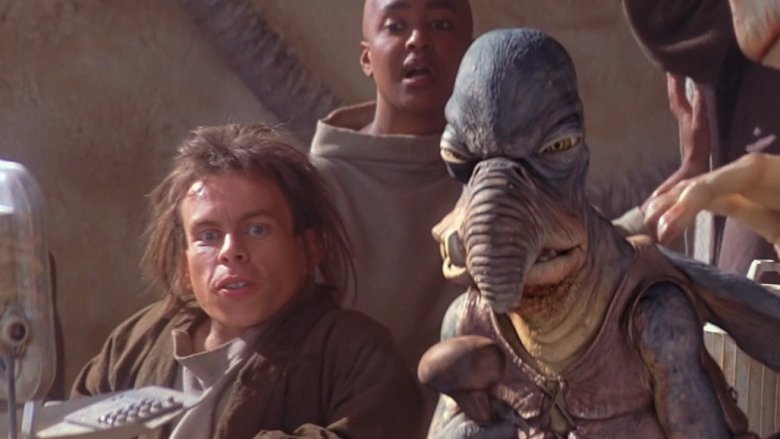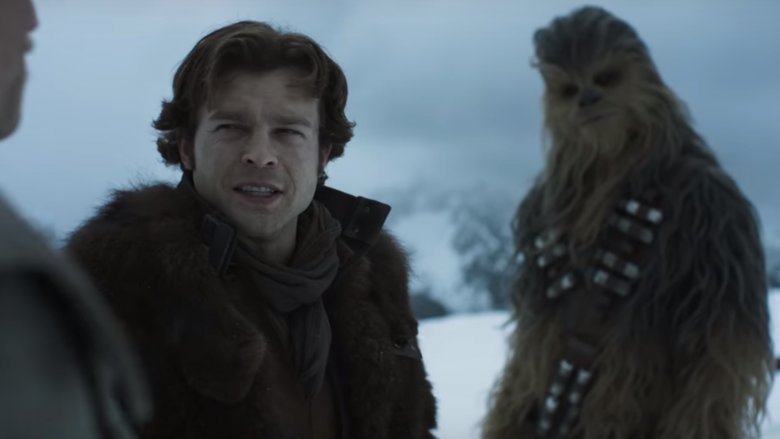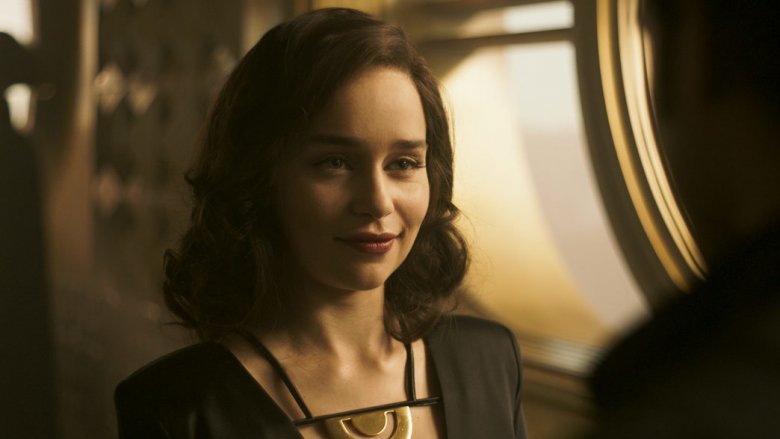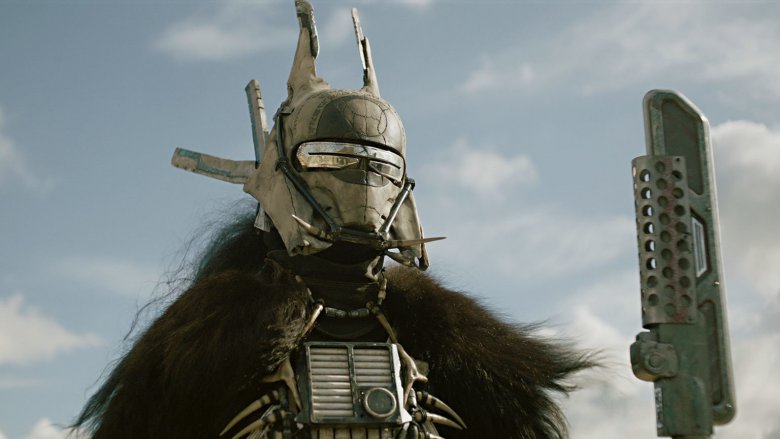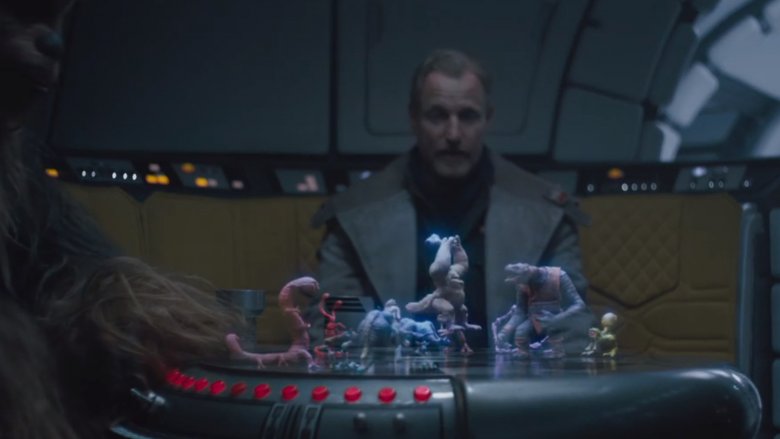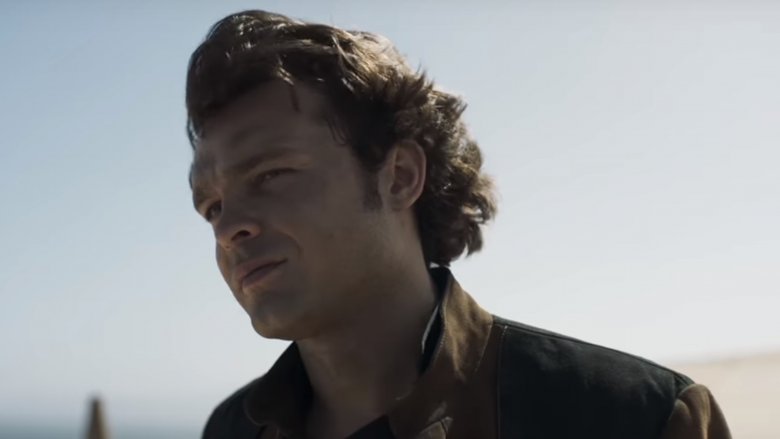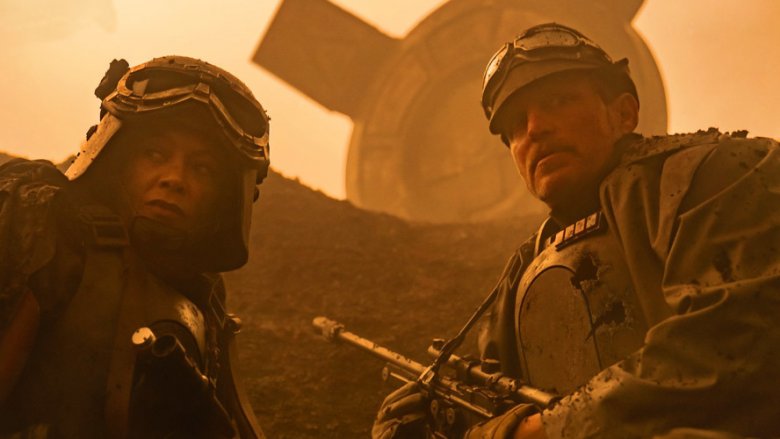Small Details You Missed In Solo: A Star Wars Story
After nearly 50 years as a cinematic icon, the galaxy's scruffiest-looking nerf herder has finally gotten a film all to himself with Solo: A Star Wars Story. As all-out, action-filled heist movies go, it's out of this world. Taking place about a decade before Han meets Luke Skywalker and Obi-Wan Kenobi as they're starting out on their fateful quest in a dingy little cantina on Tatooine, Solo gives us a pretty clear backstory about the troubled — but clearly less jaded than he thinks — aspiring young space pilot. As you might expect, there's plenty of crossover to be found here; despite our hero's general detachment and well-known cynicism about all things Jedi, it's hard to escape common threads dangling from Solo and running throughout the Star Wars universe. From name-checked bounty hunters to familiar face masks and so much more, here are the small details you may have missed in Solo: A Star Wars Story.
Stay golden
You'd be blind to not notice Han's gold dice as they appear throughout Solo, but those dice have a very strange and confusing history, and even canonical Star Wars publications can't seem to agree on what their deal is. From their first onscreen appearance during a split second of A New Hope, the dice have taken on a life of their own. Star Wars: The Force Awakens: A Visual Dictionary, usually regarded as a canonical source of Lucas lore, includes a picture of the dice: they have standard pips, and they were allegedly used in a game of Sabacc in which Han won the Millennium Falcon from Lando Calrissian.
When they make their re-appearance in The Last Jedi, their symbols have changed to alien characters, and their origin seems to remain more or less the same... until Solo. Han carries the chained pair of are dice with him until he and Qi'ra are separated on Corellia, when he hands them to her. The dice are returned to him just before the crew of the Falcon enter the spice mines of Kessel, and they definitely aren't used during Han's Sabacc showdown with a cheating Calrissian. They're not even used during Han and Lando's rematch, when Han actually scores the iconic ship. Like so much Star Wars lore, we're going to have to dig just a little deeper and figure out the real story behind those Corellian chance cubes.
Questions about Kessel
Finally, we get to see what makes the Kessel Run so dangerous, and why it's such a big deal that Han Solo made it in less than 12 parsecs, setting to rest the ongoing dork debate about a parsec being a unit of distance, not time. Because of the fancy, roundabout flying necessary to make it through this extremely volatile and dangerous area of space, finding a viable shortcut — and surviving it — is a truly big deal.
Most viewers remember Kessel because of Han's boasting; the average run takes 20 parsecs, but the Falcon made it in 12 — that is, if you round down. By the time A New Hope rolls around, Han's story grows, and that number dips to under 12. During The Force Awakens, Rey believes the number to be 14 parsecs, which Han quickly corrects.
But that's not even the first time Kessel is mentioned in Star Wars. That occurs in the first five minutes of A New Hope, when Threepio laments the fact that the Empire, currently invading the Tantive IV, might send him and Artoo to the spice mines on Kessel. It's only in Solo that we truly see exactly why the Kessel mines are so horrible for droids, and that Threepio's terror is justified. Kessel totally sucks. Even though L3-37 staged a pretty successful robot rebellion in the mines, Star Wars Rebels: The Visual Guide confirms that the mines are subject to pretty regular rebellions, all of which seem to be more or less unsuccessful. Even a decade later, Kessel is awful.
Big bounty
It wouldn't be Star Wars without bringing in a handful of weird bounty hunters from the most distant, amoral, and grossest parts of the galaxy, but unexpectedly, Solo put a definitive end to a fan favorite mercenary, and it didn't even happen onscreen.
Aurra Sing, who made a brief appearance in The Phantom Menace, went on to appear in both canonical Star Wars comics and multiple episodes of The Clone Wars, where she hung out with Boba Fett and Cad Bane, and even faced down Jedi warriors Ahsoka Tano and Plo Koon. Sometime later, she was "pushed" by Tobias Beckett and met her unceremonious end. That's it. It gives Beckett enough pull to get Lando to work with his crew of pirates, but as a once-respected bounty hunter, what a way to go.
Also mentioned in passing is Bossk, the lizard-like bounty hunter who first appears in The Empire Strikes Back. Disappointingly, the Corellian bounty hunter Dengar never makes an appearance, despite his many connections to Han.
Diving even deeper into Star Wars lore, the "Zan Sisters" are also mentioned in the same breath as Bossk, as a pair of criminals who are known to get the job done. While not an obvious — or maybe not even intentional — riff on Star Wars Legends continuity, Zan and Zu Pike were a pair of mercenary sisters who first appeared in Shadows of the Empire.
If there's any doubt that the idea of the Pike sisters and Shadows has a role in Solo, consider Teras Kasi, the martial art mentioned by Qi'ra, which she uses — as do Vos and, according to legend, Darth Maul. It's first mentioned in Shadows, is used by the Pike sisters, and has never been mentioned in canon again until now. Maybe that should have been a tipoff that Darth Maul was behind this Crimson Dawn stuff as well.
Legends
Even though Disney threw out pretty much every Star Wars comic and book that was written before they acquired Lucasfilm, the new "canon" continuity of Star Wars is more or less a remix of the old stuff; both confusing and comforting in many ways.
Lucasfilm has been toying with exploring Han's origins since Revenge of the Sith, originally planning to feature him as an orphan boy being raised by Chewbacca. Other origins, recounted in the novels The Paradise Snare and The Courtship of Princess Leia, have basically made Solo a Corellian prince of noble lineage. At one point, Han joined the Empire, didn't fit in, and eventually saved Chewbacca from the Empire's abuse. Does that last part sound familiar?
The same goes for the Maw, the gravity well at the center of the Kessel Run. While old continuity gives the name "The Maw" to a cluster of black holes, the idea is essentially the same in Solo... plus a horrifying space jellyfish for good measure. The parallels to things viewers can find in the discarded history of Star Wars are numerous, even if we'll never, ever see a Mara Jade on the big screen.
Crimson Dawn
Dryden Vos, the leader of the crime syndicate Crimson Dawn, is something of a collector, with an office full of unusual trinkets and rare specimens. Keen viewers probably noticed a suit of Mandalorian armor hanging around in the background, which is of course similar to the suits worn by both Jango and Boba Fett. How he got it is anyone's guess, but there's another curiosity in his office that probably turned even more heads.
Director Ron Howard announced before the release of Solo that he'd planted an Indiana Jones Easter egg in the film, carrying on a long tradition of the two franchises trading references. Howard cites Raiders of the Lost Ark as the connection, and apparently, treasures from the Sankara Stones to the fertility idol are hidden throughout the room. While he wasn't explicit in what viewers should be watching for, one more obvious treasure is the gigantic crystal skull that Vos has prominently displayed. Vos' skull is definitely more humanoid than the alien cranium found in the obviously-titled Kingdom of the Crystal Skull, but it's almost definitely a reference to the Indiana Jones film and a 1980 novel, Han Solo and the Lost Legacy. Exploring the rest of Vos' cool toys will have to wait for the Blu-ray release and heavy use of the pause button.
Aboard the Falcon
Everything you know is wrong. For decades, all we've really known of the Millennium Falcon is that it's a temperamental, hearty little ship with weird, jutting arms out front. Dig a little deeper into the origins of the ship and you'll know that it's one of many Corellian Freighters, and that slot in the middle is used to tow heavy cargo through the galaxy. Watch Solo, however, and you might not even recognize the ship.
During Han and Lando's first trip, we see that the ship is very clean, and also unusually teardrop shaped, with a whole lot of additions made by Lando himself to make it more of a pleasure vehicle than one for just serious business. These additions include a cape room, a Dejarik holochess table, and some relatively nice sleeping quarters. The new shape of the Falcon actually reflects the original designs of artist Ralph McQuarrie.
Despite all the damage it's sustained by the end of Solo, and various parts falling off, one thing we know for sure remains aboard the Falcon is Lando's bounty hunter helmet, which we first see in Return of the Jedi when Lando enters Jabba's palace using the name Tamtel Skreej. Here, we see Beckett using the same helmet to disguise himself on Kessel.
Digging deep
Lando clearly isn't a fan of mining colonies, which he calls "the worst." Either his mind is changed or the money is right, because by the time The Empire Strikes Back rolls around, Calrissian is managing Cloud City, a Tibanna gas mining colony over Bespin. Keep your eyes peeled on the Falcon and you'll spot a silver model of the colony among Lando's possessions.
Speaking of clouds, it may also come as a surprise that Enfys Nest and her Cloud Riders actually aren't a completely original creation for Solo. They're actually inspired by a band of marauders who appeared in 1978's Star Wars #9, but only in appearance. The comic Cloud-Riders are led by a guy with the terrible name "Arrogantus," who definitely isn't into piracy to help the Rebellion. By then, Marvel's Star Wars comics were already far off the rails: Jabba the Hut (with one 't') was a skinny yellow walrus on two legs, and Luke and Han were hanging out with a hedgehog man named Hedji and a barely-clothed crime boss lady named Amaiza.
Weazel and the gang
Solo isn't littered with as many secret cameos as other recent Star Wars films, but a few are worth mentioning.
First, it would be hard to miss the unusual presence of Clint Howard, brother of director Ron Howard, and a regular face for fans of science fiction. You'll spot him as a robot wrangler when we first meet L3-37, but you might also recognize him from the classic Star Trek episode "The Corbomite Maneuver," or as environmentalist Johnny Bark in Arrested Development.
And while this is a very rare Star Wars movie that doesn't feature C-3PO, it still features the Droid's actor, Anthony Daniels, as Tak, a character that teams up with Chewbacca during the escape from Kessel. This marks the third character Daniels has played in Star Wars, having appeared as Dannl Faytonni in Attack of the Clones and Revenge of the Sith.
Of course, there's also Darth Maul, played again by actor Ray Park, but voiced by Maul's Clone Wars voice actor Sam Witwer. Casual Star Wars fans might be absolutely perplexed by Maul's reappearance after being chopped in half and falling down a bottomless pit during his first film, but his complicated history — and his new robotic legs and home on Dathomir, along with his fancy new lightsaber — very strangely and unexpectedly tie into Solo when we find out that Maul is kind of Vos and Qi'ra's boss.
Finally, we have Warwick Davis, who's been a part of Star Wars since the very beginning, playing multiple characters, but most notably Wicket the Ewok. Of all of his Star Wars characters, only one is unmasked: Weazel, a scuzzy spectator at the Boonta Eve podrace on Tatooine during The Phantom Menace. An unmasked Davis appears again as a member the Cloud Riders, once again credited as Weazel. Going from a racing junkie on a dirt planet to being one of the galaxy's founding freedom fighters is an arc to parallel anyone else in Star Wars, so if this is indeed the same Weazel, it's an arc we need to see.
Familiar parlance
Screenwriters Jonathan and Lawrence Kasdan had a tough job creating the script for Solo. Not only did the duo have to sift through mountains of lore and saga history to make this individual puzzle piece fit in the grand scheme some 10 years prior to the events of A New Hope, but they also had to find ways of incorporating some of Han's choicest phraseology without making it too cheesy.
The easiest nods to the character's previous pieces of dialogue were direct, like when Han is referred to as a "flyboy" by his new cohorts on Tobias Beckett (Woody Harrelson)'s team and when he calls his new friend Chewbacca a "moof-milker" for the first time. At other points, the approach was to turn a well-known phrase on its head. Instead of the classic "I have a bad feeling about this" bit that makes its way into every Star Wars movie, Han's delight at taking the wheel of the Millennium Falcon inspires the happier "I have a really good feeling about this."
One of the more creative mini-adjustments comes when Lando Calrissian (Donald Glover) has decidedly had enough of the coaxium heist mission and all the damage it's doing to his precious Millennium Falcon; he tells Han, "I hate you," and Han replies, "I know." It's an nod to the signature exchange he'll later have with Leia Organa, and clearly demonstrates the strong emotional effect Han's had on people from the beginning.
Too tough to tangle with
In addition to preceding A New Hope, Solo also takes place before Rogue One: A Star Wars Story, and the film overtly tells us as much by including Scarif among the many familiar planet names that are dropped by characters throughout. While there are plenty of other familiar locales that should make Star Wars' aficionados' ears perk up — Beckett wanting to get back to Glee Anselm, Mimban being the muddy site of Han and Chewie's imprisonment — the mention of Scarif is about much more than letting us know it's still intact in the timeline of Solo. It also reaffirms just how gutsy the events of Rogue One really were.
Scarif is mentioned by Qi'ra (Emilia Clarke) as a possible source of some replacement coaxium after Beckett's team muffs their attempt to boost some from a train in Vandor-1 thanks to the unexpected arrival of Enfys Nest's "marauders." That option is quickly passed over because of the heavy security surrounding the planet, and the group instead opts to risk the Kessel Run (and being incinerated by unstable fuel cells) rather than even take a chance at Scarif. In other words, Jyn Erso and her band of rebels were even braver than we knew.
The beginning of a rebellion
The first standalone Star Wars story, Rogue One, was basically a feature-length tribute to some of the previously unknown heroes that helped fuel the rebellion that would ultimately topple an empire — and got those Death Star plans into Leia Organa's hands. Solo, on the other hand, is focused on the history and character development of our leather-loving friend and prove he was known to act unselfishly on at least one occasion prior to saving Luke Skywalker from Darth Vader's squadron of TIE fighters.
There's a lot of discussion in Solo about what it means for Han to betray Dryden Vos (Paul Bettany) and deliver the fuel cells to Enfys Nest's team. Before, he was ready to align with anyone who'd call him a pilot and fill his pockets, but now he has scruples and guts. What really seems to matter is not the reluctant good guy status this act affords him, though; rather, there seems to be a potential ripple effect the deed may have on the rebellion as a whole. Enfys Nest tells Han the coaxium "is the blood that brings life to something new: a rebellion." It might not be as obvious a connection to the events of A New Hope as the Rogue One team literally transmitting those blueprints to Leia's ship, but the connection is still clear: long before Han would ever meet Luke and Obi-Wan at that Mos Eisley Cantina, he'd already begun his work aiding the Rebel Alliance.
Winks to the outliers
Throughout Solo, there are a lot of Easter eggs for fans, from the mention of Aurra Sing's assassination to the design of the Millennium Falcon that hearkens back to Ralph McQuarrie's original drawings. Some are a little more obscure than others, though.
Lando Calrissian, for example, uses some downtime to chronicle his adventures via hologram and makes mention of the alien Sharu. This is a major nod to L. Neil Smith's Lando Calrissian and the Mindharp of Sharu, a novel which offers its own pre-war adventure tale of Lando and a droid going on a treasure hunt. The book also spells out the detailed parameters of the card game Sabacc, so perhaps this was director Ron Howard's way of saying thank you. The book and its sequels might not have gotten much onscreen love in the past, but the scene seems to finally give weight to those crazy adventure stories (embellished as they may have been).
Solo also gives a nod to Phil Tippett and Jon Berg's missing holochess characters, Bulbous and Scrimp, which were omitted from the Dejarik boards shown in A New Hope and The Force Awakens but were kept by the artists as souvenirs of their Star Wars adventures. In a Solo scene aboard the Millennium Falcon, Chewbacca is shown learning the game with Beckett and attempting to wipe the pieces away in a moment of typical frustration, causing two pieces to blink out of existence.
Who shoots first
Perhaps no Star Wars issue has been so furiously debated as whether Han Solo shot first in his fateful tussle with Jabba the Hutt's henchman Greedo at the Cantina in A New Hope. The conflicting opinions over whether Han hit the trigger in retaliation for — or to preempt — Greedo's own gunning has been a hot-button issue for some fans (even if others think it's inarguable that he got the upper hand, and on purpose).
Solo doesn't answer that specific question, precisely, but it does pay homage to it with a new, much more conclusive version of similar events. In the film's final scenes, Han confronts Beckett on the beach after his mentor betrayed him by alerting Vos to his plans to deliver the coaxium to Enfys Nest. The two engage in a war of words before it becomes clear their differences can't be resolved in a peaceful manner. Using what has quickly become his signature blaster pistol — given to him by Beckett, no less — Han decides to act first and whips out his weapon and puts a blast into Beckett's chest before he can even draw his own sidearm. Just in case the reference wasn't already clear enough, the struggling Beckett then proceeds to compliment Han on his smart decision to shoot first.
Going to the goon
In Solo, Han's driven by two central desires: rescuing his gal pal Qi'ra from Corellia — then the clutches of Dryden Vos and the Crimson Dawn — and earning his wings as a bona fide pilot with his own ship. By the time we meet him in A New Hope, however, he's become a full-fledged smuggler with a homicidal former client in Jabba the Hutt, driven mostly by his greed (and the bounty on his head).
Solo teases that future, even after painting Han as the good guy for his contribution to Enfys Nest's burgeoning rebellion, by telling us what his next move will be. Beckett earlier makes mention of a rumor that "a big shot gangster is putting together a crew" on Tatooine, and Han decides to follow that lead. "Big shot gangster" might not be the most obvious way to describe Jabba the Hutt, but it's still pretty clear that's where he's headed, for better (meeting Luke) and for worse (ripping off Jabba and getting frozen in carbonite for his transgression).
